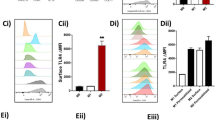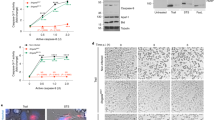Abstract
An invading pathogen must be held in check by the innate immune system until a specific immune response can be mounted. In the case of Gram-negative bacteria, the principal stimulator of the innate immune system is lipopolysaccharide (LPS), a component of the bacterial outer membrane1. In vitro, LPS is bound by lipopolysaccharide-binding protein (LBP)2 and transferred to CD14—the LPS receptor on the macrophage surface3,4—or to high-density lipoprotein (HDL) particles5,6. Transfer to CD14 triggers an inflammatory response which is crucial for keeping an infection under control. Here we investigate how LBP functions in vivo by using LBP-deficient mice. Surprisingly, we find that LBP is not required in vivo for the clearance of LPS from thecirculation, but is essential for the rapid induction of an inflammatory response by small amounts of LPS or Gram-negative bacteria and for survival of an intraperitoneal Salmonella infection.
This is a preview of subscription content, access via your institution
Access options
Subscribe to this journal
Receive 51 print issues and online access
$199.00 per year
only $3.90 per issue
Buy this article
- Purchase on Springer Link
- Instant access to full article PDF
Prices may be subject to local taxes which are calculated during checkout




Similar content being viewed by others
References
Rietschel, E. T. et al. Bacterial endotoxin: molecular relationships of structure to activity and function. FASEB J. 8, 217–225 (1994).
Schumann, R. R. et al. Structure and function of lipopolysaccharide binding protein. Science 249, 1429–1431 (1990).
Wright, S. D., Ramos, R. A., Tobias, P. S., Ulevitch, R. J. & Mathison, J. C. CD14, a receptor for complexes of lipopolysaccharide (LPS) and LPS binding protein. Science 249, 1431–1433 (1990).
Tobias, P. S., Soldau, K., Gegner, J. A., Mintz, D. & Ulevitch, R. J. Lipopolysaccharide binding protein mediated complexation of lipopolysaccharide with soluble CD14. J. Biol. Chem. 270, 10482–10488 (1995).
Tobias, P., Soldau, K. & Ulevitch, R. J. Isolation of a lipopolysaccharide binding acute phase reactant from rabbit serum. J. Exp. Med. 164, 777–793 (1986).
Wurfel, M. M., Kunitake, S. T., Lichenstein, H., Kane, J. P. & Wright, S. D. Lipopolysaccharide (LPS)-binding protein is carried on lipoproteins and acts as a cofactor in the neutralization of LPS. J. Exp. Med. 180, 1025–1035 (1994).
Wurfel, M. M. & Wright, S. D. Lipopolysaccharide binding protein and soluble CD14 transfer lipopolysaccharide to phospholipid bilayers. J. Immunol. 158, 3925–3934 (1997).
Nowicka, G., Brüning, T., Böttcher, A., Kahl, G. & Scmitz, G. Macrophage interaction of HDL subclasses separated by free flow isotachophoresis. J. Lipid Res. 31, 1947–1963 (1990).
Nowicka, G., Brüning, T., Grothaus, B., Kahl, G. & Schmitz, G. Characterisation of apolipoprotein B containing lipoproteins separated by preparative free flow isotachophoresis. J. Lipid Res. 31, 1173–1186 (1990).
Schmitz, G., Möllers, C., Böttcher, A. & Ploch, J. in Handbook of Lipoprotein Testing (eds Rifai, N., Warnick, G. R. & Dominiczak, M. H.) 477–495 (AACC, Washington DC, (1997)).
Ulevitch, R. J. The preparation and characterisation of a radioiodinated bacterial lipopolysaccharide. Immunochemistry 15, 157–164 (1978).
Haziot, A. et al. Resistance to endotoxin shock and reduced dissemination of Gram negative bacteria in CD14 deficient mice. Immunity 4, 407–414 (1996).
Gallay, P., Heumann, D., Le Roy, D., Barras, C. & Glauser, M.-P. Mode of action of anti-lipopolysaccharide binding protein antibodies for prevention of endotoxemic shock in mice. Proc. Natl Acad. Sci. USA 91, 7922–7926 (1994).
Galanos, C., Freudenberg, M. A. & Reutter, W. Galactosamine induced sensitization to the lethal effects of endotoxin. Proc. Natl Acad. Sci. USA 76, 5939–5943 (1979).
Grunwald, U. et al. Monocytes can phagocytose Gram-negative bacteria by a CD14 dependent mechanism. J. Immunol. 157, 4119–4125 (1996).
Jack, R. S., Grunwald, U., Stelter, F., Workalemahu, G. & Schütt, C. Both membrane bound and soluble forms of CD14 bind to Gram-negative bacteria. Eur. J. Immunol. 25, 1436–1441 (1995).
Freudenberg, M. A. & Galanos, C. Tumor necrosis factor alpha mediates lethal activity of killed Gram-negative and Gram-positive bacteria in d-galactosamine-treated mice. Infect. Immun. 59, 2110–2113 (1991).
Schütt, C. et al. Human monocytes lacking the membrane-bound form of the bacterial lipopolysaccharide (LPS) receptor CD14 can mount an LPS-induced oxidative burst response mediated by a soluble form of CD14. Res. Immunol. 146, 339–350 (1995).
Author information
Authors and Affiliations
Corresponding author
Rights and permissions
About this article
Cite this article
Jack, R., Fan, X., Bernheiden, M. et al. Lipopolysaccharide-binding protein is required to combat a murine Gram-negative bacterial infection. Nature 389, 742–745 (1997). https://doi.org/10.1038/39622
Received:
Accepted:
Issue Date:
DOI: https://doi.org/10.1038/39622
This article is cited by
-
Tolerized Microglia Protect Neurons Against Endotoxin-Induced TNF-α Production via an LBP-Dependent Intracellular p38 MAPK Signaling Pathway
Inflammation (2023)
-
Regulators of Salmonella-host interaction identified by peripheral blood transcriptome profiling: roles of TGFB1 and TRP53 in intracellular Salmonella replication in pigs
Veterinary Research (2018)
-
Hepatocytes: a key cell type for innate immunity
Cellular & Molecular Immunology (2016)
-
Association of TLR1, TLR2, TLR4, TLR6, and TIRAP polymorphisms with disease susceptibility
Immunologic Research (2015)
-
Reducing the bioactivity of Tannerella forsythia lipopolysaccharide by Porphyromonas gingivalis
Journal of Microbiology (2014)
Comments
By submitting a comment you agree to abide by our Terms and Community Guidelines. If you find something abusive or that does not comply with our terms or guidelines please flag it as inappropriate.



